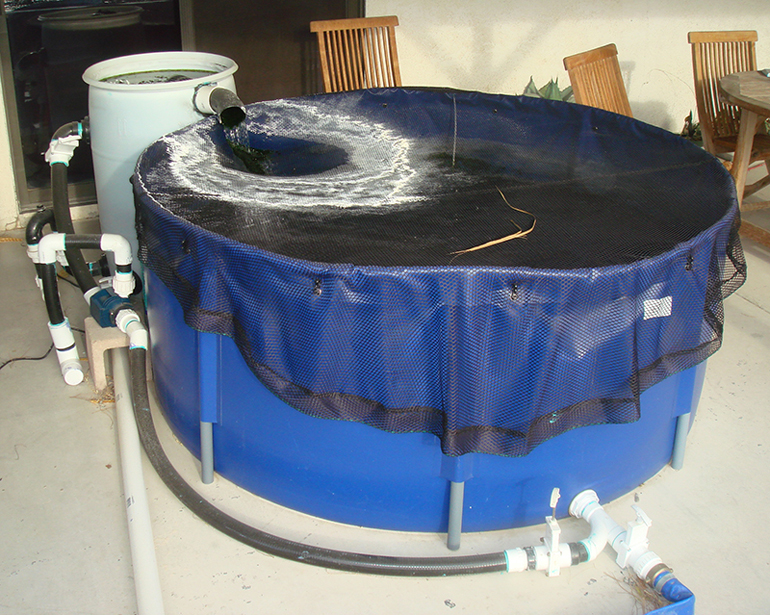
Winter is here, so I feel it’s time to revisit short-term pon quarantine systems. Quarantine is a practice used for winterizing fish in colder climates, caring for sick fish and separating new arrivals for a period before introducing them into your existing system. It’s important to have a system that’s easy to set up, tear down and store. The system must be large enough to easily contain your fish without crowding and have enough filtration to handle the ammonia load produced. Winterizing requires a larger system than short-term quarantine, because there are more fish involved in the process.
Many times, short-term quarantine has minimal filtration with lots of oxygen, because the time it takes to mature a bacterial colony can be longer than the quarantine period. Caring for a sick fish also doesn’t require much biofiltration, and some medications can have adverse effects on the bacteria creating the nitrate cycle anyway. When this is the case, frequent water-quality testing and water changes are the norm. Good circulation is important, and building a system that has a working bottom drain as the primary outlet is always better than removing the water from the side or top. In larger bodies of water, water stratifies, with the worst water quality at the bottom and the best at the top, so moving water from the bottom to the top is important. A quarantine system is much smaller in volume, but that’s no reason to treat it differently than you would a larger system.
In a small short-term system, prefiltration or mechanical filtration is the primary goal. The water can move through a gravity-flow outlet to a prefilter from a bottom drain, with a submersible pump in the prefilter that flows water back to the tank or through a direct-suction pump from the tank to a filter and back to the tank. The system must always include a source of dissolved oxygen, which can be an air stone or another form of small-bubble creation in the tank or biofilter, if it’s an open-gravity flow filter. Just letting water splash back into the tank is not enough.
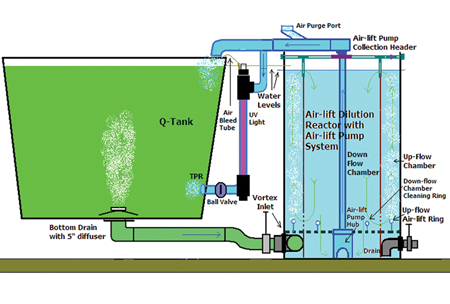
When using direct suction, a 1 ½ or 2-inch outlet is adequate, but when building a gravity-flow system, the outlet must be 3 or 4 inches in diameter. Direct suction is much more hazardous to the fish, and I would recommend always using a large screen over the outlet to prevent a fish from getting sucked in or damaged. I prefer gravity flow for its safety, because the larger pipe sizes slow the linear speed of the water through the piping and don’t create high suction when blocked.
Smaller-Scale Systems
One tried and true way to speed up the initial bioconversion process is to remove the media from the filter of choice a few weeks before quarantine and place them in your pond somewhere convenient. They will collect bacteria and detritus and start becoming active media. Just pull them from your pond and place them in the quarantine system filter when needed. Once media have been used, they should never be stored or sealed, as they will go anaerobic. Always store them in an open container where they can dry out. Even used media that have dried out over time will kick-start much faster than new media, because much of the bacteria doesn’t really die off. This practice can help a smaller system get started in a shorter amount of time.
>> More best practice articles on motors, design and filtration challenges.
Adding starter bacteria to a system with no fish in it is usually a waste of time. With no fish in the tank, the bacteria won’t have any ammonia to convert, so they will just stay dormant until they have a food source. It is possible to prestart a system with ammonia and starter bacteria and test until you get nitrite and nitrate readings. It won’t be equivalent to your fish load in most cases, but it will grow rapidly from there.
Larger Systems
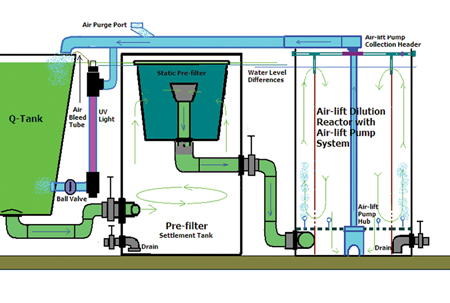
In larger systems used for longer terms or a higher fish load, a prefilter and biofilter combination is preferred. Whatever size system your trying to build, remember the total turnover rate must be much higher than in your pond. Your pond should be at a once-per-hour minimum to twice per hour, depending on the size — and it usually falls somewhere between the two. The smaller the system, the higher the turnover rate should be. A typical quarantine system might be three or four times per hour. I like making filters out of 55-gallon drums because they are inexpensive, and you can do almost anything with them. These drums might seem too large for a quarantine system, but considering that inadequate filtration volume is one of the biggest problems we face in the hobby — they’re not. When using them as prefilters or for static biofiltration, the speed of the water through them should not exceed 2,000 gallons per hour. When using them as an aerated biofilter of any type, there isn’t necessarily a speed limit. The bioconversion is almost instantaneous between the ammonia and bacteria, but when trapping solids, the speed must be kept down to allow for good water clarity and better trapping ability.
A 3-inch bottom drain line attached to a 55-gallon-drum vortex and static prefilter of some type will flow 1,800 to 2,000 gph at a 1-inch drop of water level between the tank and drum. Sized with an appropriate pump or a larger pump that is restricted with a valve on the outlet side, a 55-gallon-drum biofilter can be added with the water returning over the edge of the tank as a return. This type of open, upflow biofilter can be aerated easily, improving performance and eliminating the need for in-tank aeration.
Trickle Towers
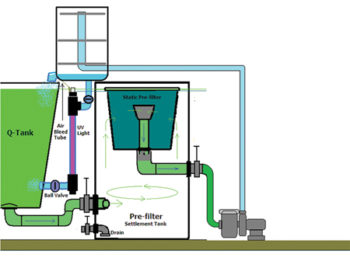
Shower filters, or trickle towers, are also a great form of aerated biofiltration. The filter container is placed on a stand above the edge of the tank, and the pumped water flows down through the shower and back into the tank. Shower filter media can be dried and stored and will usually kick-start quickly when the system is set up again. Ceramic media are extremely useful for this, as the bacteria will imbed in the porous surface of the media in ways they cannot in plastic media. Skimmers are not usually installed on quarantine systems, because they are typically too large and require too much flow for most weirs to operate on a small system. They also can create a danger for small fish in a small system. Last year, I created a smaller 4-inch circular weir skimmer that works great on smaller ponds and quarantine systems with a flow rate as low as 300 gph.
Dual & Airlift Systems
My own — or I should say, “my wife’s” — quarantine systems are both types. The first is a small “hospital” system consisting of a 350-gallon tank with a 3-inch bottom drain connecting to a 55-gallon-drum prefilter. The system is smaller for convenience, so the drum is cut down to match the height of the tank set on one row of cinder blocks. The blocks also create a space for the bottom drain plumbing underneath. A small 1,200-gph external pump moves the water to a 55-gallon-upflow static media filter that pours back into the tank. The media in both the prefilter and the biofilter is Bacti-twist, which is easily cleaned and disinfected when necessary, allowing this small system to be used as a hospital tank. Aeration is provided with an air stone located in the 1 ¼-inch bulkhead in the lower side.
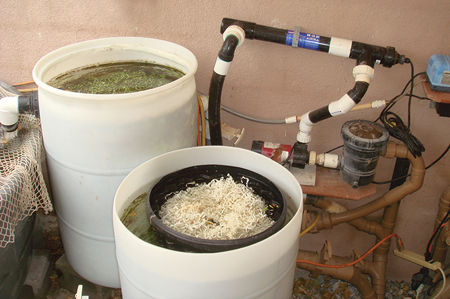
The larger system is a 1,500-gallon W. Lim preformed pond raised to the height of a 55-gallon drum. It has a 4-inch aerated bottom drain reduced to 3 inches before it goes into the 55-gallon drum prefilter. I reduce it at a sweep tee, because I use this system as well as the smaller one for testing equipment. The water is pumped to a 55-gallon-drum shower filter that spills back into the tank. I use a WLim Wave I 1/15-horsepower pump at 3,000 gph, which is more than my prefilter should flow, but it works. The water level runs about 2 inches lower than the tank, which is more than I want, but it works. The addition of my new skimmer on the suction side will correct the flow from the bottom drain by reducing the suction from the prefilter. The media in the shower filter is Bacti-twist in the upper basket and Cermedia MP-2C in the lower basket.
Recently, I’ve moved to creating quarantine systems that run on air, both for the simplicity and the real-time dissolved oxygen content. An airlift system can be one or two tanks — or more. The airlift is created inside the filter, which makes the system easy to set up, operate, disassemble and store. Three and 4-inch bottom drain piping is a must, as airlift flow is, at its core, gravity-flow in both directions. The airlift lowers the level of water in the filter, creating flow from the tank to the filter, and raises it just above water level in the tank for the return.
Whatever system you build, it needs to fit your needs. Calculate the size based on your use, and create something that works for you!


